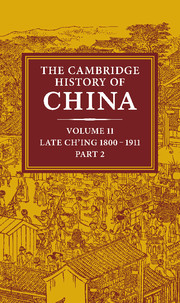Book contents
- Frontmatter
- 1 Economic trends in the late Ch'ing empire, 1870–1911
- 2 Late Ch'ing foreign relations, 1866–1905
- 3 Changing Chinese views of Western relations, 1840–95
- 4 The military challenge: the north-west and the coast
- 5 Intellectual change and the reform movement, 1890–8
- 6 Japan and the chinese revolution of 1911
- 7 Political and institutional reform 1901–11
- 8 Government, merchants and industry to 1911
- 9 The republican revolutionary movement
- 10 Currents of social change
- Bibliographical essays
- Bibliography
- Index
- Map 1. Ch’ing empire – physical features
- References
6 - Japan and the chinese revolution of 1911
Published online by Cambridge University Press: 28 March 2008
- Frontmatter
- 1 Economic trends in the late Ch'ing empire, 1870–1911
- 2 Late Ch'ing foreign relations, 1866–1905
- 3 Changing Chinese views of Western relations, 1840–95
- 4 The military challenge: the north-west and the coast
- 5 Intellectual change and the reform movement, 1890–8
- 6 Japan and the chinese revolution of 1911
- 7 Political and institutional reform 1901–11
- 8 Government, merchants and industry to 1911
- 9 The republican revolutionary movement
- 10 Currents of social change
- Bibliographical essays
- Bibliography
- Index
- Map 1. Ch’ing empire – physical features
- References
Summary
The modern transformations of China and Japan were inextricably interrelated. With the advent of steam navigation both countries found isolation untenable, and the appearance of Western gunboats in the harbours of each had significance for the other. Cultural ties and a shared written language meant that the response of either country was quickly accessible to the other, and observation of the process of challenge and response invited reflection and appropriation. China's crisis with the West preceded that of Japan by a good decade and a half; Japan became fully involved with the international order in 1860, the same year that the Ch'ing Summer Palace was consumed by flames kindled by the British-French expedition. Thereafter the determination of Japanese leaders to preserve national unity against the foreigner drew reinforcement from the ruinous disunity of China in the 1860s. Soon Japan's drive for modernization provided encouragement and a warning for China. By the turn of the century Japan's leap to international equality had made its institutions the natural focus of learning for a generation of young Chinese.
The rapid shift of images each country held of the other during these years provides a field for analysis that is only now becoming fruitful. In Japanese eyes the Chinese changed from the thoughtful, introspective sages who peopled the paintings of the Tokugawa artists to the hapless rabble the print makers of 1895 showed in full flight before Japan's modern troops. Eventually they became the awkward, self-conscious students who drew the hoots of street urchins for their hair and dress in early twentieth-century Tokyo.
- Type
- Chapter
- Information
- The Cambridge History of China , pp. 339 - 374Publisher: Cambridge University PressPrint publication year: 1980
References
- 4
- Cited by

